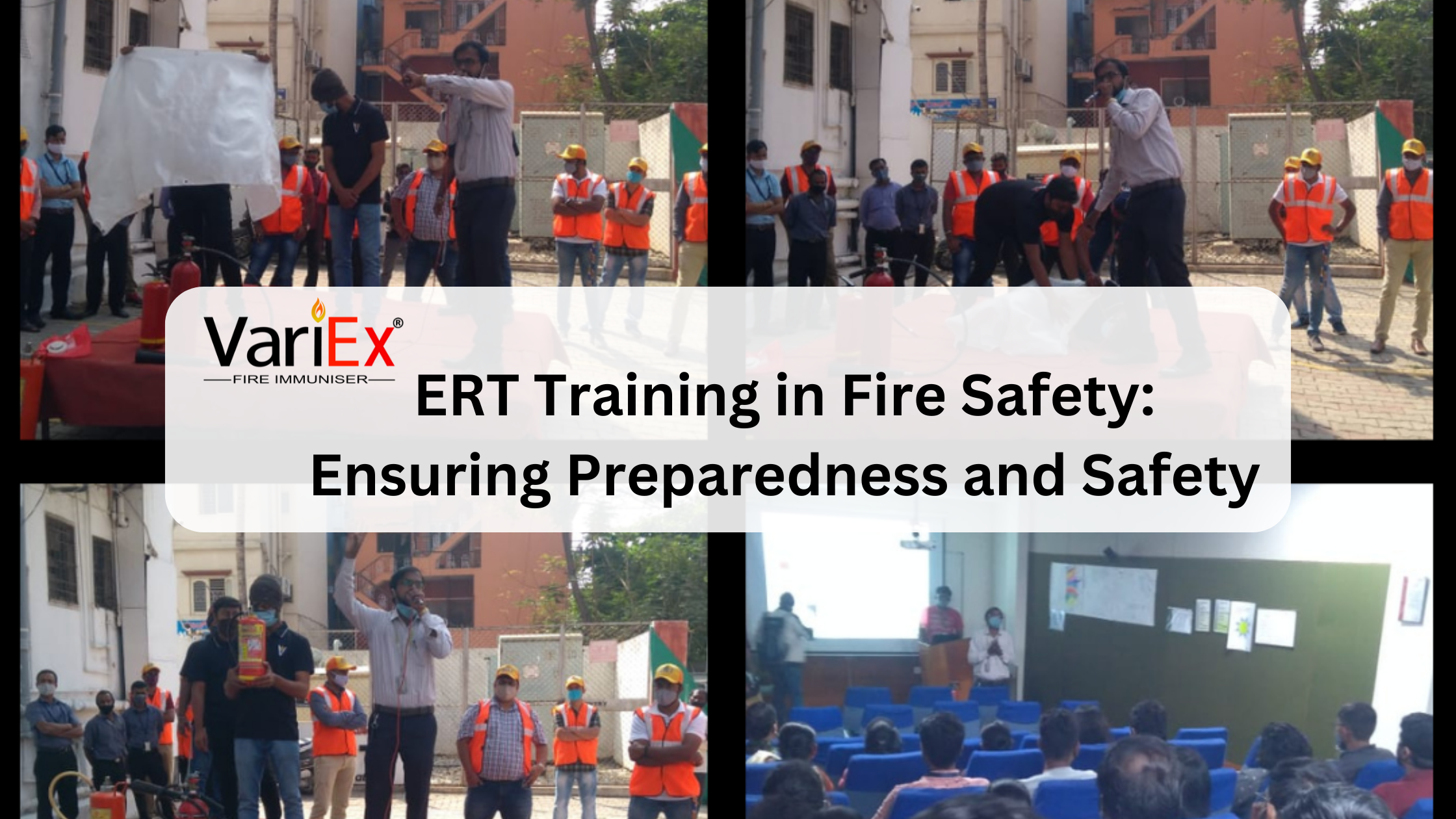![]()
Fire Immuniser
+91-7829629111
Email: info@variex.in
Varistor Technologies Pvt. Ltd.
Block-1, First Floor, Ardente Office One, Hoodi Circle, ITPL Main Road, Bengaluru, Karnataka 560048, IN
ERT Training in Fire Safety: Ensuring Preparedness and Safety
Emergency Response Team (ERT) training in fire safety plays a crucial role in safeguarding workplaces and communities. This comprehensive training equips individuals with the skills and knowledge necessary to respond effectively to fire emergencies, mitigating risks and ensuring swift action in critical situations.
What Is ERT Training?
ERT training is designed to educate designated personnel within organizations about fire safety protocols, emergency response procedures, and the operation of firefighting equipment. Participants typically undergo theoretical instruction combined with practical simulations to simulate real-life scenarios. This training ensures that ERT members are prepared to handle various emergency situations confidently and efficiently.
Importance of ERT Training
- Rapid Response: ERT members are trained to respond swiftly to fire incidents, minimizing damage and potential harm to people.
- Risk Mitigation: Through thorough training, ERT members can identify fire hazards, conduct safety inspections, and implement preventive measures to reduce the likelihood of fires.
- Safety Compliance: ERT training ensures compliance with safety regulations and standards, fostering a secure working environment.
- Employee Safety: When employees know that trained personnel are ready to respond to emergencies, it enhances overall safety awareness and confidence in workplace safety protocols.
Advantages of ERT Training
- Effective Emergency Response: ERT members are trained in first aid, fire suppression techniques, evacuation procedures, and using firefighting equipment such as fire extinguishers and hoses. This enables them to act swiftly and effectively during emergencies, potentially saving lives and minimizing property damage.
- Enhanced Preparedness: Regular training updates and drills keep ERT members sharp and ready to handle evolving fire safety challenges. They learn to adapt to different scenarios, ensuring they can react calmly and effectively under pressure.
- Team Cohesion: ERT training fosters teamwork and collaboration among participants. By working together during simulations and drills, team members build trust and communication skills essential for coordinated emergency response.
- Cost Savings: Proactive fire safety measures and a well-trained ERT can significantly reduce the financial impact of fires on businesses. Quick containment and response can prevent extensive damage and operational downtime.
- Compliance and Accreditation: Many industries and regulatory bodies require organizations to have trained ERT members as part of their safety protocols. Compliance with these standards not only ensures legal requirements are met but also enhances the organization's reputation for safety and reliability.
Key Components of ERT Training:
- Fire Safety Protocols: Participants learn about fire prevention measures, detection systems, and safety protocols specific to their workplace. This includes understanding fire hazards, fire behavior, and the importance of early detection.
- Emergency Response Procedures: ERT members are trained in emergency response procedures such as evacuation plans, assembly points, and communication protocols during emergencies. They practice drills to simulate real-life scenarios and improve response times.
- Use of Firefighting Equipment: Training covers the proper use and maintenance of firefighting equipment such as fire extinguishers, hoses, and evacuation devices. Participants gain hands-on experience in deploying these tools effectively.
- First Aid and Medical Response: Basic first aid training is often included to enable ERT members to provide immediate assistance to injured individuals until professional medical help arrives. This may include CPR, basic wound care, and handling medical emergencies related to fire incidents.
- Teamwork and Communication: Effective teamwork and communication are critical during emergencies. ERT training emphasizes clear communication channels, leadership roles during crises, and coordination among team members to ensure a unified response.
- Risk Assessment and Management: ERT members learn how to assess risks associated with fire hazards and implement proactive measures to mitigate these risks. This includes conducting regular inspections, identifying potential fire hazards, and implementing preventive actions.
- Legal and Regulatory Compliance: Understanding relevant safety regulations and compliance requirements is essential. ERT training ensures participants are aware of legal obligations and industry standards related to fire safety and emergency response.
In conclusion, ERT training in fire safety is indispensable for any organization committed to protecting its people, assets, and operations. By investing in comprehensive training programs, businesses not only comply with regulations but also foster a culture of safety that benefits everyone involved. Effective ERTs are the backbone of proactive fire safety measures, ensuring readiness and resilience in the face of emergencies.
Frequently Asked Questions
ERT training, or Emergency Response Team training, is a structured program designed to prepare designated individuals within organizations to respond effectively to fire emergencies. It includes theoretical instruction and practical exercises to equip participants with the skills and knowledge necessary for swift and safe emergency response.
ERT training is typically attended by employees designated as part of the organization's emergency response team. These individuals may include fire wardens, safety officers, designated first aiders, and others responsible for emergency procedures and firefighting tasks.
ERT training offers several benefits, including:
- Enhanced emergency response capability
- Reduced impact of fire incidents
- Improved safety and risk management
- Compliance with regulations
- Boosted employee confidence and morale
- Cost savings through minimized damage and downtime
- Improved teamwork and communication among team members
- Continuous improvement of emergency preparedness plans and procedures
ERT training covers a range of topics essential for effective emergency response, including:
- Fire safety protocols and procedures
- Use and maintenance of firefighting equipment
- Evacuation plans and procedures
- First aid and medical response
- Risk assessment and management
- Legal and regulatory compliance
The frequency of ERT training sessions may vary based on industry regulations, organizational policies, and the nature of the workplace. Generally, refresher training should be conducted regularly (e.g., annually or biannually) to ensure that ERT members remain proficient in their skills and updated on any changes in protocols or equipment.
Final Say
At VariEx.in and VariexOnline.com, we specialize in supplying and installing top-quality fire fighting systems and equipment. From fire extinguishers to advanced suppression systems, we offer comprehensive solutions tailored to your needs. Our experienced team ensures precise installation and maintenance for optimal safety.
Trust VariEx for reliable fire protection. Contact us online or call 7829629111 to learn more.
"WHAT YOU CAN READ NEXT"
 Read more +24 November 2023 in Fire Extinguisher
Read more +24 November 2023 in Fire ExtinguisherWhat types of fire extinguishers are available for different fire classes?
 Read more +11 July 2025 in Fire Suppression
Read more +11 July 2025 in Fire Suppression







